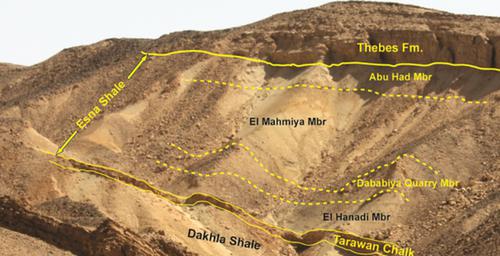当前位置:
X-MOL 学术
›
Geolog. J.
›
论文详情
Our official English website, www.x-mol.net, welcomes your
feedback! (Note: you will need to create a separate account there.)
Biostratigraphy and depositional environments of the Palaeocene–Eocene succession at Um El Huwaitat area, Eastern Desert, Egypt
Geological Journal ( IF 1.4 ) Pub Date : 2020-11-24 , DOI: 10.1002/gj.4024 Tarek Anan 1 , Abdalla Shahin 1
Geological Journal ( IF 1.4 ) Pub Date : 2020-11-24 , DOI: 10.1002/gj.4024 Tarek Anan 1 , Abdalla Shahin 1
Affiliation

|
The Palaeocene–Eocene succession in southwest Safaga, Eastern Desert, Egypt has been studied to determine its lithostratigraphic units, biostratigraphic zonation, microfacies association, and depositional environments. The variation in lithofacies allows the subdivision of the Danian–Ypresian interval into four lithostratigraphic units that are arranged, from base to top, as the Dakhla Shale (only its upper part), Tarawan Chalk, Esna Shale, and Thebes Formation (only its lower part). Moreover, the Esna Shale is further subdivided into four members, arranged from base to top, as El Hanadi, Dababiya Quarry, El Mahmiya, and Abu Had. The depositional setting is interpreted to primarily reflect the relative sea‐level changes. The planktonic/benthic (P/B) foraminiferal ratio is indicative of oscillations of depositional settings in normal open marine conditions, ranging from shallow inner to outer neritic environments. Biostratigraphically, the Palaeocene–Eocene succession in the studied area is subdivided into 12 biozones and subbiozones. These are correlated with the standard biozonation of the Palaeocene–Eocene. Deposition of the Palaeocene–Eocene succession in the studied area took place on a relatively stable shelf. Three lithofacies were recognized: shale, marl, and limestone. The shale lithofacies is differentiated into two sub‐lithofacies; pure shale and calcareous foraminiferal shale, whereas marl lithofacies contains abundant planktonic foraminifera. The encountered carbonate rocks comprise eight microfacies types. In addition, the studied interval is correlated with the Global Standard Stratotype Section and Point in the Dababiya section, south of Luxor, Egypt.
中文翻译:

埃及东部沙漠Um El Huwaitat地区古新世-始新世演替的生物地层学和沉积环境
已经对埃及东部沙漠萨法加西南部的古新世-始新世演替进行了研究,以确定其岩石地层学单位,生物地层分区,微相联系和沉积环境。岩相的变化允许将Danian–Ypresian区间细分为四个岩性地层学单位,从底部到顶部依次排列为Dakhla页岩(仅上部),Tarawan Chalk,Esna页岩和Thebes地层(仅下部)部分)。此外,埃斯纳页岩进一步细分为四个成员,从下到上依次为El Hanadi,Dababiya Quarry,El Mahmiya和Abu Had。沉积环境被解释为主要反映相对海平面的变化。浮游/底栖(P / B)有孔虫比率表明在正常的开放海洋条件下沉积环境的波动,范围从浅的内部到外部环境。在生物地层学上,研究地区的古新世-始新世演替分为12个生物区和亚生物区。这些与古新世-始新世的标准生物区带有关。在研究区域中,古新世-始新世演替的沉积是在一个相对稳定的层架上进行的。识别出三个岩相:页岩,泥灰岩和石灰岩。页岩岩相分为两个亚岩相。纯页岩和钙质有孔虫页岩,而泥灰岩岩相含有丰富的浮游有孔虫。遇到的碳酸盐岩包括八种微相类型。此外,
更新日期:2020-11-24
中文翻译:

埃及东部沙漠Um El Huwaitat地区古新世-始新世演替的生物地层学和沉积环境
已经对埃及东部沙漠萨法加西南部的古新世-始新世演替进行了研究,以确定其岩石地层学单位,生物地层分区,微相联系和沉积环境。岩相的变化允许将Danian–Ypresian区间细分为四个岩性地层学单位,从底部到顶部依次排列为Dakhla页岩(仅上部),Tarawan Chalk,Esna页岩和Thebes地层(仅下部)部分)。此外,埃斯纳页岩进一步细分为四个成员,从下到上依次为El Hanadi,Dababiya Quarry,El Mahmiya和Abu Had。沉积环境被解释为主要反映相对海平面的变化。浮游/底栖(P / B)有孔虫比率表明在正常的开放海洋条件下沉积环境的波动,范围从浅的内部到外部环境。在生物地层学上,研究地区的古新世-始新世演替分为12个生物区和亚生物区。这些与古新世-始新世的标准生物区带有关。在研究区域中,古新世-始新世演替的沉积是在一个相对稳定的层架上进行的。识别出三个岩相:页岩,泥灰岩和石灰岩。页岩岩相分为两个亚岩相。纯页岩和钙质有孔虫页岩,而泥灰岩岩相含有丰富的浮游有孔虫。遇到的碳酸盐岩包括八种微相类型。此外,











































 京公网安备 11010802027423号
京公网安备 11010802027423号